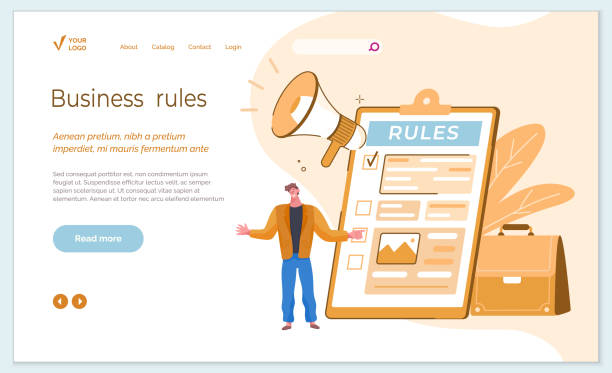Introduction to Responsive Website Design: Why is this capability essential?

#Responsive_Website_Design #Responsive_Web #Importance_of_Responsive
In today’s world, where users access the internet from various devices, responsive website design is no longer a luxury option, but an undeniable necessity.
From smartphones and tablets to laptops and wide monitors, every device has different screen dimensions.
A website designed only for desktop will provide an undesirable user experience on mobile, and vice versa.
The concept of responsive design means designing a website that can automatically adapt its layout and elements to the screen size of the user’s device.
This means providing a unified and optimized user experience across all platforms.
When a website is properly responsive, users do not need to zoom in, scroll horizontally, or struggle to find information on a cluttered page.
This capability not only increases user satisfaction but also directly impacts your site’s SEO, as search engines like Google prioritize responsive websites in their rankings.
Ignoring the importance of this approach in the digital age means losing a large portion of your audience and business opportunities.
So, let’s delve deeper into this topic and see why every business needs a responsive website? and how to best leverage its benefits.
This is an educational and explanatory discussion that every developer and business owner should be familiar with to be able to compete in today’s competitive world.
The importance of responsive website design goes beyond aesthetics; it’s a strategic investment for your digital future.
These fundamental principles are crucial for responsive website design.
Are you worried about losing customers because you don’t have a professional e-commerce website?
With e-commerce website design by Rasawp, forget these worries!
✅ Significant increase in sales and visitor-to-customer conversion rate
✅ Professional and user-friendly design that builds customer trust
⚡ Get free consultation from Rasawp
Key Principles and Concepts in Responsive Website Design

#Responsive_Concepts #Media_Queries #Flexible_Grids
For successful implementation of responsive website design, familiarity with three main concepts is essential: flexible grids, flexible images, and media queries.
Flexible grids mean that instead of using fixed widths (pixels), relative units like percentages are used to determine the width of elements.
This allows the website’s layout to automatically scale with screen size changes, preventing clutter.
Flexible images, using the max-width: 100%; property in CSS, ensure that images never exceed their container and scale proportionally with it.
This feature is crucial for preventing horizontal scrolling and maintaining visual appeal across different devices.
But the most important tool in responsive design is media queries.
Media queries allow developers to apply different CSS styles based on device characteristics (such as screen width, height, orientation, and resolution).
For example, you can specify that for widths less than 768 pixels, the navigation menu converts to a hamburger icon or fonts become smaller.
This specialized approach forms the core of any responsive website and provides precise control over the site’s appearance and behavior at various sizes.
By combining these three principles, we can create a site that not only looks good on any device but also provides an excellent user experience.
This educational approach is essential for anyone wishing to enter the world of responsive website design.
Effective Tools and Frameworks in Responsive Website Design

#Responsive_Tools #Web_Frameworks #Responsive_Development
To simplify the responsive website design process, numerous tools and frameworks have been developed that make the work easier for designers and developers.
Bootstrap is undoubtedly the most popular CSS framework, which includes responsive grid systems, UI components, and JavaScript plugins.
Using Bootstrap, one can quickly build professional-looking responsive websites without having to write a large amount of CSS code from scratch.
Tailwind CSS takes a different approach, being a Utility-First framework that allows you to apply custom and responsive styles directly in your HTML using predefined CSS classes.
In addition to frameworks, other tools such as browser developer tools (like Chrome DevTools) are very useful for testing and debugging responsive design.
These tools allow you to view your website in various screen sizes and mobile device simulators, and identify and fix weaknesses.
Furthermore, the use of Content Management Systems (CMS) like WordPress with responsive themes has made the responsive website design process accessible even for non-technical individuals.
These tools provide an important part of the expertise needed to create a modern website and help you overcome technical challenges.
Below is a table of some of these tools and frameworks that can help you choose the best option for your project.
Choosing the right tool for responsive web development can make a significant difference in the speed and quality of your project.
This is a guidance and specialized aspect for every web designer.
| Tool/Framework Name | Type | Key Features |
|---|---|---|
| Bootstrap | CSS/JS Framework | Responsive grid system, UI components, JS plugins |
| Tailwind CSS | Utility-First CSS Framework | Utility classes for direct styling, high customization |
| Chrome DevTools | Browser Tool | Device simulator, responsiveness check, debugging |
| WordPress (with responsive themes) | Content Management System | Ease of creating and managing responsive sites |
The Impact of Responsive Website Design on User Experience (UX)

#User_Experience #Responsive_UX #Customer_Satisfaction
User Experience (UX) plays a vital role in the success of any website, and responsive website design directly impacts it.
When a user visits your website from any device and encounters an optimized and understandable user interface, their sense of satisfaction and trust in your brand increases.
Non-responsive websites often lead to issues such as the need for frequent zooming, small and unclickable buttons, or a cluttered layout, all of which result in a poor user experience.
These issues not only cause users to quickly leave the site but can also damage your brand’s reputation.
In contrast, a proper responsive design simplifies navigation, improves content readability, and ensures that all website functionalities are accessible and usable, regardless of screen size.
Optimizing user experience for mobile devices, which account for a large portion of web traffic today, is of high importance.
This not only increases the user’s time spent on the site but also improves the Conversion Rate.
Users are more inclined to make purchases or obtain information from websites that are easy and pleasant to use.
This aspect of responsive website design is a deep analysis of user behavior and needs, which ultimately benefits the business.
An excellent user experience converts users into loyal customers, and this is one of the biggest advantages of responsive website design.
Do you have an e-commerce website, but your sales aren’t as expected? Rasawp solves your problem forever with professional e-commerce website design!
✅ Significant increase in conversion rate and sales
✅ Unparalleled user experience for your customers
⚡ Click to get free consultation from Rasawp!
SEO Benefits and Search Engine Ranking with Responsive Website Design

#Responsive_SEO #Google_Ranking #SEO_Improvement
One of the most important reasons that makes responsive website design vital for any business is its positive impact on SEO and search engine rankings.
Google, as the world’s largest search engine, has explicitly stated that it prefers responsive websites over those with separate mobile versions (e.g., m.example.com).
The reason for this is that a responsive website has only one URL and one codebase, which makes it easier for Google’s bots to manage and crawl.
This prevents duplicate content issues and keeps the site’s SEO power focused.
Furthermore, page loading speed on mobile devices is one of Google’s key ranking factors, and proper responsive design can help improve loading speed.
Also, the improved user experience resulting from responsive website design (such as lower bounce rate and longer dwell time) sends positive signals to Google, indicating your site’s high quality and relevance.
In April 2015 and then in 2018 with the introduction of Mobile-First Indexing, Google officially announced that it considers the mobile version of websites as the primary version for indexing and ranking.
This means that if your website is not optimized for mobile, you may experience a significant drop in mobile search results.
Therefore, responsive website design is not only a specialized recommendation but also an analytical and strategic requirement for success in the digital world, so that your site can keep pace with Google’s algorithms and win in online competition.
Future Trends and Emerging Technologies in Responsive Website Design

#Responsive_Web_Trends #New_Web_Technology #Future_of_Design
The world of responsive website design is constantly evolving, with emerging technologies and new trends appearing to further improve user experience across various devices.
One such trend is the Mobile-First approach, which is no longer merely a recommendation but an industry standard for responsive design.
This means that designers first design for the smallest screen (mobile) and then gradually scale up for larger devices (tablet and desktop).
This approach ensures that the site is optimized for mobile from the outset.
Progressive Web Apps (PWAs) technologies are also changing the game.
PWAs offer a combination of the best features of web and native applications, including offline functionality, sending notifications, and installation on the device’s home screen, all of which significantly improve the mobile user experience.
Also, Artificial Intelligence (AI) and Machine Learning (ML) have great potential for personalizing user experience in responsive website design.
For example, AI can dynamically adjust content or layout based on user usage patterns or the type of device being used.
Responsive website design quickly adapts to these innovations through news published in the web industry and moves towards optimizing the user experience even more intelligently and automatically than before.
This is an analytical aspect that helps developers prepare for the future and utilize the latest technologies in their projects.
Common Mistakes in Responsive Website Design and Solutions

#Responsive_Mistakes #Web_Design_Solution #Best_Practices
While responsive website design offers many benefits, improper implementation can lead to numerous problems.
One of the most common mistakes is neglecting testing on actual devices.
Browser simulators are useful, but they cannot always accurately show the site’s performance on real smartphones or tablets.
Another mistake is the incorrect use of media queries, which can lead to complex and unmanageable code.
Instead of using many media queries with fixed width ranges, it is better to use a Mobile-First approach and use media queries only to apply changes at specific points (Breakpoints).
Also, neglecting image optimization for different devices can lead to slow loading speeds and wasted user bandwidth.
Using responsive images with the <picture> tag or the srcset attribute can solve this problem.
Important guidance is to pay attention to small details such as font sizes, padding, and margin on different devices to ensure that the content is readable and accessible.
Many designers mistakenly believe that responsive website design is only about layout resizing, whereas it is actually about overall user experience optimization for any environment.
By avoiding these common mistakes and following best practices, one can ensure that a responsive design is truly effective and efficient.
The table below lists some of these problems and their solutions, which will help you improve your responsive website design.
This is a specialized and guidance section for web developers.
| Common Problem | Explanation | Solution |
|---|---|---|
| Non-optimized images | Large images that slow down loading speed. | Using srcset, <picture>, image compression. |
| Ignoring real mobile testing | Relying on simulators that may not be accurate. | Testing on real mobile phones and tablets. |
| Complex mobile navigation | Cluttered and unusable menus on small screens. | Hamburger menus, simple and intuitive navigation. |
| Inappropriate Breakpoints | Incorrect selection of style change points based on device width. | Identifying points where content breaks, not just common device dimensions. |
The Impact of Responsive Website Design on Conversion Rate and Profitability

#Conversion_Rate #Web_Profitability #Business_Improvement
Responsive website design not only affects user experience and SEO but is also directly related to the Conversion Rate and, consequently, your business profitability.
Conversion rate refers to the percentage of website visitors who complete a desired action (such as purchasing a product, filling out a contact form, or subscribing to a newsletter).
When your website functions well on any device and provides a seamless user experience, the likelihood of users completing your desired actions significantly increases.
Imagine a user browsing on their mobile and intending to make a purchase from your online store.
If your website is not optimized for mobile, the purchasing process will be difficult and unpleasant, and the user will likely simply leave the page and turn to a competitor who has a responsive website.
In contrast, a website with strong responsive website design simplifies the payment process, makes forms usable, and displays content in a way that users can easily find the information they need.
This means an increase in conversion rate, a decrease in bounce rate, and ultimately, an increase in revenue for your business.
Investing in responsive website design is an analytical and smart decision that yields significant returns in the long run and helps you stand out in today’s competitive market.
This is an explanatory topic to demonstrate the added value of a principled design.
Tired of your company’s website not being seen as it deserves and losing potential customers? With professional and effective website design by Rasawp, solve this problem forever!
✅ Increase brand credibility and build customer trust
✅ Attract targeted sales leads
⚡ Call us now for a free consultation!
Challenges and Solutions for Content Management in Responsive Website Design

#Responsive_Content_Management #Content_Challenges #Content_Optimization
Despite all the advantages, responsive website design also presents challenges in content management.
The main challenge is how to design content so that it remains optimized and readable across different screen sizes.
Excessive or disorganized content can become cluttered or even disappear on smaller screens.
One solution is content prioritization.
The most important information should be placed at the top of the page so that users receive the main message at a glance, without needing to scroll extensively.
Using techniques like “content folding” (hiding less important content and displaying it only on click) can also be helpful.
Furthermore, optimizing images and videos for a responsive website is crucial.
Using appropriate image formats, file compression, and Lazy Loading can help loading speed and improve user experience.
Responsive design also requires a flexible content strategy.
This means content should be written to be layout-independent and easily understandable at any size.
This is a question-provoking discussion on how to find the best balance between content volume and readability across different devices.
However, with careful planning and the use of appropriate content management tools, these challenges can be overcome, and an attractive and optimized responsive website with engaging content can be delivered.
This process is a specialized and guidance section that helps content managers perform optimization in the best possible way.
Cost and Investment in Responsive Website Design

#Responsive_Cost #Web_Investment #Website_Design_Price
One of the key questions for businesses is: How much does responsive website design cost? And is this investment economically justified? At first glance, responsive website design might seem more expensive than traditional design, as it requires more expertise and time for implementation and testing across different devices.
However, this issue should be examined from a long-term perspective.
In the past, businesses had to design and maintain two separate websites (one for desktop and one for mobile).
This approach not only doubled development costs but also made content management, SEO, and updates more complex and time-consuming.
With responsive website design, you have only one website that performs optimally across all devices.
This means that maintenance, SEO, and update costs are significantly reduced.
In addition to long-term cost savings, the Return on Investment (ROI) from increased conversion rates, improved SEO rankings, and enhanced customer satisfaction provides a strong economic justification for this investment.
The question-provoking content in this section can answer these questions: Is the risk of losing mobile customers and dropping in Google rankings worth the small savings in initial costs? Absolutely not.
Therefore, responsive design is not only a smart investment but also an essential step to maintain competitiveness and growth in the digital age.
This is an analysis of the financial dimensions of this project, showing why this investment is vital for the future of the business.
Frequently Asked Questions
| Question | Answer |
|---|---|
| What is Responsive Web Design? | A web design approach that ensures a website displays well and provides a suitable user experience across various screen sizes and devices (like mobile, tablet, desktop). |
| Why is responsive design important? | Improved user experience, better SEO (Google prefers responsive sites), saving time and cost (no need to build a separate site for mobile). |
| What are the main techniques in responsive design? | Using flexible grids and layouts (Fluid Grid), flexible images and media (Flexible Images), and utilizing Media Queries in CSS. |
| What are Media Queries in responsive design? | A part of CSS3 that allows you to apply different styles based on the characteristics of the device on which the website is displayed (such as screen width, resolution, media type). |
| What are the benefits of using responsive design? | Access to more users (especially mobile), improved user engagement rate, reduced maintenance costs (one site for all devices), and improved conversion rate. |
And other advertising services of Rasawp Advertising Agency
Ads focusing on seasonal hygiene products on classified websites
How to optimize ads for hygiene product sales for high conversion
Advertising manufactured men’s hygiene products on classified websites
The importance of timing in publishing ads for care products
Ads for specific hygiene products on specialized classified websites
And over hundreds of other services in the field of internet advertising, advertising consultation, and organizational solutions
Internet Advertising | Advertising Strategy | Advertorial
🚀 Are you ready for your business to leap forward in the digital world? Rasawp Afarin Digital Marketing Agency, with expertise in SEO, content marketing, and responsive website design, is with you to reach the peak.
📍 Tehran, Mirdamad Street, next to Bank Markazi, Southern Kazeroon Alley, Ramin Alley, No. 6

